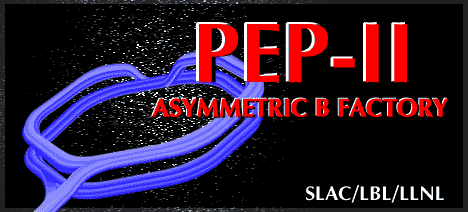 05/26/99 Update
05/26/99 Update  05/26/99 Update
05/26/99 Update The first five day period was down for BaBar repairs to fix (primarily) electronics on the electromagnetic calorimeter. On recovery PEP-II had difficulty storing beams. We found that the BaBar work had "bumped" the forward accelerator raft and moved it about 6 mm horizontally. The bump came most likely during closing the forward detector steel doors. After realignment of the raft the accelerator beams returned to normal. Studies have started into the why this happened. Position sensors between the support tube and the drift chamber clearly show this bump. These sensors have also indicated temperature related horizontal diurnal movements of approximately half a millimeter. This additional effect is also under study but is related to air flow in and out of the hall.
Work on the coupling correction of the BaBar solenoid continues. Neither ring is perfectly decoupled. The present situation is that with the design skew quadrupole settings the measured luminosity is lower. Our ability to measure and adjust coupling has improved but the full solution is not yet found. An offline fit to oscillation data has produced an improved HER IR coupling solution. However, in practice we add specific skew quadrupole perturbations to one or both rings to produce a higher luminosity. These perturbations drift with time and the peak luminosity drifts down a factor of two over a period of one to two days. Fortunately, restoring a "good" magnet configuration from a few days to a week ago including resteering the interaction region recovers the luminosity. A minimum vertical capsigma beam size of 9.2 microns has been achieved. The inferred average beam size is 6.5 microns.
Over the past year the HER has had an unusually low threshold for transverse instability with multi-bunches. We have recently isolated part if not most of the problem to the interaction region. By changing the horizontal angle of the electrons in the interaction point the instability comes and goes. Finding the location of the mode has not been done. However, since the LER does not see this brand of instability, the Y-chambers where the beams separate are likely not the location. More likely are the insertion quadrupole chambers (Q4-Q5) in the HER or the downstream high power dump.
More work has been done on the nonlinear pressure rise with current with positrons in the LER. We now have a beam pipe solenoid over 100 m of one straight section. We can make up to 50 gauss. The beam pipe solenoid makes the threshold higher at the 10% level in current and the rate of pressure rise up to a factor of two or three lower. Bunch spacings of 4, 6 and 8 buckets have been tried. What appears to matter is the charge per bunch and not the spacing. Changing the beam orbit several millimeters to make it off center in the chamber also helps the pressure rise on the order of a factor of two. The present threshold is at about 700 mA with 8 bucket bunch spacing and 415 bunches.
The peak luminosity in PEP-II has ranged from 2 to 4 x 10**32/cm**2/s during recent BaBar data taking. PEP-II has delivered about 220 pb^-1 so far and BaBar has logged about 162 pb^-1. The HER has integrated about 75 A-hr since May and the LER 245 A-hr. The peak LER current has been 910 mA and the HER 300 mA.
John Seeman 8/6/99
Suggestions to: John Seeman
[PEP-II Commissioning Updates] [PEP-II Home Page] [BABAR Detector Home Page] [SLAC Home Page]
Page owner: achan